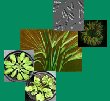| Beck, E; Burkert, A; Hofmann, M: Uptake of l-ascorbate by intact spinach-chloroplasts, Plant Physiology, 73, 41-45 (1983), doi:10.1104/pp.73.1.41 | |
| Abstract: Uptake of l-[1-14C]ascorbate by intact ascorbate-free spinach (Spinacia oleracea L. cv Vitalr) chloroplasts has been investigated using the technique of silicone oil filtering. Rates greater than 100 micromoles per milligram chlorophyll per hour (external concentration, 10 millimolar) of ascorbate transport were observed. Ascorbate uptake into the sorbitol-impermeable space (stroma) followed the Michaelis-Menten-type characteristic for substrate saturation. A Km of 18 to 40 millimolar was determined. Transport of ascorbate across the chloroplast envelope resulted in an equilibrium of the ascorbate concentrations between stroma and medium. A pH optimum of 7.0 to 7.5 and the lack of alkalization of the medium upon ascorbate uptake suggest that only the monovalent ascorbate anion is able to cross the chloroplast envelope. The activation energy of ascorbate uptake was determined to be 65.8 kilojoules (16 kilocalories) per mole (8 to 20°C). Interference of ascorbate transport with substrates of the phosphate or dicarboxylate translocator could not be detected, but didehydroascorbate was a competitive inhibitor. Preloading of chloroplasts with didehydroascorbate resulted in an increase of Vmax but did not change the Km for ascorbate. Millimolar concentrations of the sulfhydryl reagent p-chloromercuriphenyl sulfonate inhibited ascorbate uptake. The data are interpreted in terms of ascorbate uptake into chloroplasts by the mechanism of facilitated diffusion mediated by a specific translocator. |

Letzte Änderung 24.06.2020

